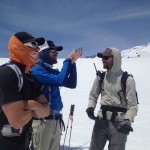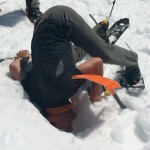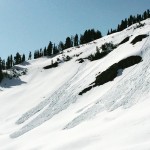May 6, 2015
- A fine looking bunch. (Photo: Brenda Hollon)
- When it comes to avalanche terrain slope angle is a big piece of the puzzle. IMG guide Liam O’Sullivan uses a sighting clinometer to check slope angles. (Photo: Brenda Hollon)
- IMG Guide Johnny Schrock taking a look at it. Johnny making some snow temperature observations.
- What’s better than talking about avalanches? Seeing them live and in person. Several human triggered avalanche near Edith Creek.
One thing I love about life is that we never stop learning. There is always more to learn, new to know, skills to refine. Last week eight IMG guides and two Alpine Ascents International guides got together at IMG’s headquarters in Ashford, WA for an American Institute of Avalanche Research and Education (AIARE) Level 2. This intense 40 hour course takes a look at snow, weather, and avalanche observations, and how to formulate opinions of avalanche hazard based on this information. If you’re thinking, man my head already spinning, me too. However, through the collective knowledge of the group with some facilitation by the two instructors we reached this goal.
Most avalanche education focuses on the use and interpretation of the avalanche bulletin from the local backcountry avalanche center (for us that’s the Northwest Avalanche Center) for tour planning and decision making. This makes sense. We are fortunate to have dozens of snow professionals contributing to theses avalanche forecast. However, what do you do if you are traveling in an area without a recreational avalanche forecast? In the case of our guide staff, the majority of our trips occur in areas or in times of the year where the backcountry avalanche forecast is unavailable. Therefore we wanted to develop and practice a higher level of skill.
We began our course building a solid foundation of understanding mountain weather, how it builds the mountain snowpack, what factors strengthen/weaken the snowpack, and how this manifest itself in avalanche terrain as distinct avalanche problems. Once you’ve identified the beast you’re dealing with, now we can plan accordingly. So, now it’s time to build solid trip plans complete with intentional observations of the weather and snow to add to our understanding of the current state of the snowpack.
The final step is the hardest, climb or ski like you mean it. Yep, that’s it. Once you’ve done the work to get informed, plan according to the information, the only thing left is to go out there and have fun. As you can imagine for a group of guides training together in the mountains, this is our favorite part. So, when you see some smiles in the pictures, that’s just us hard at work training.
Dallas Glass




